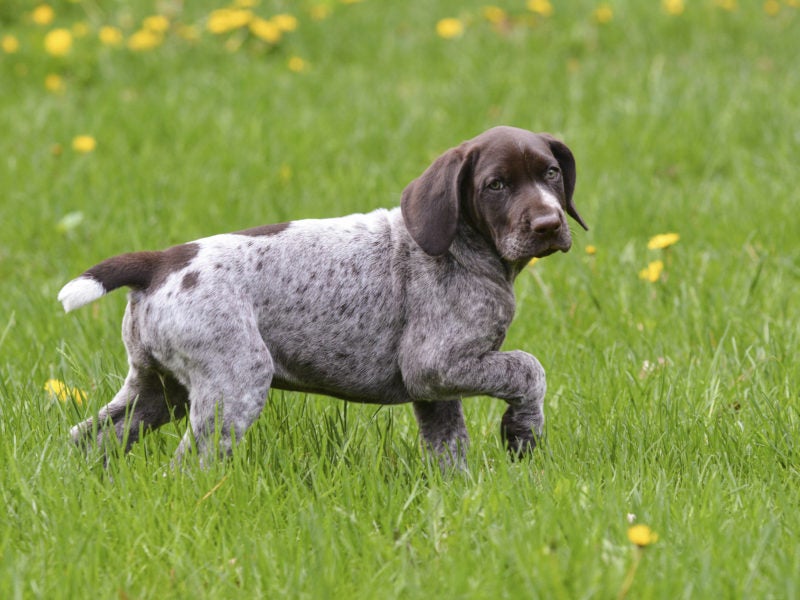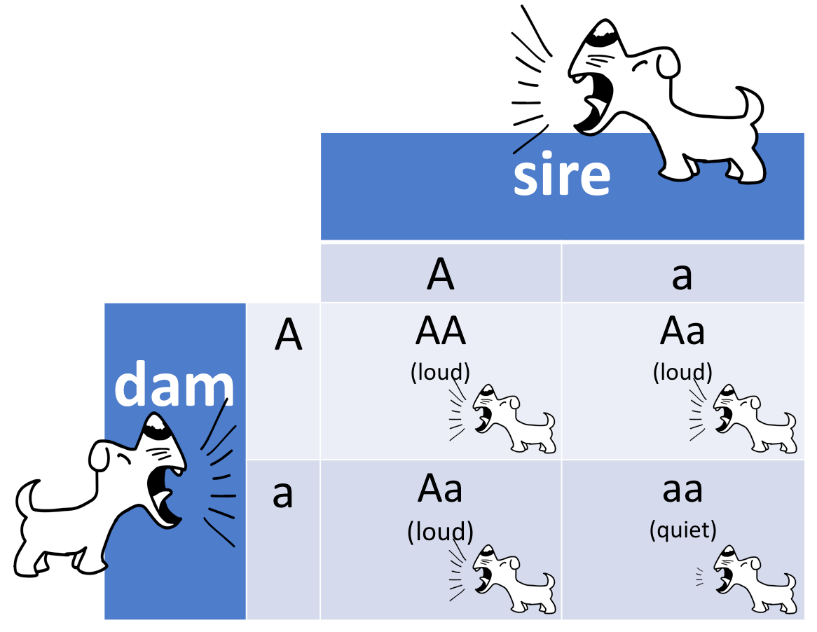
Read part one and part two of this series.
Genetics is a fundamental field of biology that covers the passage of genetic information to successive generations (inheritance). More broadly, genetics covers the study of genes, how they are organized in cells, how they are regulated, and how they interact with each other and the environment. Genetics is a key component of genomics, a much broader area of the life sciences that is highly interdisciplinary and considers the structure, function, mapping and both natural and induced alterations of genomes.
Over the course of a series of short articles, we will cover the basics of what DNA is and how it is organized in cells, how cells divide and pass genetic information to the next generation, and how genetic variation (inherited and sporadic) impacts disease, and how purebred dogs can help advance genetic research.
How Are Genes Inherited?
Understanding how genes are passed from parent to offspring (inherited) requires a basic knowledge of some key terms.
- Allele – one or more alternative form of a gene.
- Homozygous – the two copies of the gene indicated are represented by the same allele.
- Heterozygous – the two copies of the gene indicated are represented by different alleles.
- Genotype – the set of genes that an individual possesses, inherited from the parents.
- Trait – a physical, behavioral, biochemical, or physiological characteristic, e.g. eye color, coat texture, etc.
- Phenotype – the appearance or manifestation of a trait (this may be physical, behavioral, biochemical, or physiological. This is what we can see or measure, e.g. blue eyes, straight coat.)
After mating, when fertilization occurs, the haploid set of chromosomes carried by each of the gametes of the male and female (sperm and egg) fuse to form a zygote. At the exact time of fertilization, the zygote thus acquires a diploid set of chromosomes; one haploid set from the mother and one from the father. A puppy, therefore, inherits a copy of the genome from each parent, with half the genes in each cell being derived from each parent. As such, for each autosomal gene, as well the sex chromosomes of a female puppy, there is a paternally and a maternally derived (inherited) copy. In males, the X and Y chromosomes carry different gene sets and so these are present only as one copy.
Every gene has one or more variant forms, called alleles. Since each individual has only two copies of each gene, an individual can only have two alleles even if there are many more across the population. If the allele of a gene inherited from both parents is the same, the gene is said to be homozygous. If the offspring inherits a different allele of a gene from each parent, the offspring is referred to as heterozygous for that gene. There are approximately 20,000 genes distributed across the canine genome, each with a specific function. When we consider the alleles of multiple genes we refer to the combination possessed by an individual as the genotype. It is the enormous number of possible combinations of genes that lead to genetic variation and explains why no two individuals (except identical twins[1]) share the same genotype and hence phenotype for each trait.
Is it All in The Genes?
Most traits are influenced by numerous genes and impacted by the environment. For these traits, deciphering the pattern of inheritance is very complex and beyond the scope of this introductory piece. A small number of traits are primarily controlled by a single gene and so have a more predictable pattern of inheritance.
Most textbooks will highlight the major forms of inheritance as being either dominant or recessive. We will briefly explain the basics of these two simple inheritance patterns, but be aware that these terms can be misleading.
As we stated above, while each gene may be represented by one or more alleles, an individual can only have two alleles (a paternally and a maternally derived allele). The alleles may result in different phenotypes. Hypothetically, for fun, let’s assume we are looking at a single dog gene that we will call WOOF, which only has two alleles, ‘A’ and ‘a’. Allele ‘A’ results in loud barking and allele ‘a’ results in quiet barking.
When we look across the population we notice that dogs either bark loudly or quietly, but we do not observe dogs barking at a mid-volume. We also notice that many more dogs bark loudly than quietly. This type of scenario could be explained by the ‘A’ allele (loud barking) being fully dominant to the ‘a’ allele (quiet barking), which is referred to as ‘recessive’. For this reason, notation dictates that the dominant allele is represented in an uppercase letter (in this case ‘A’) and the recessive allele is represented by a lowercase letter (in this case ‘a’).
With only these two alleles there are only three possible genotypes, AA, Aa, and aa. Since there are only two phenotypes, LOUD and QUIET, the presence of the A allele ‘vetoes’ the presence of the ‘a’ allele. We thus have the following summary:
Gene = WOOF
Alleles = A (loud barking); a (quiet barking)
| GENOTYPE | PHENOTYPE |
| AA | loud barking |
| Aa | loud barking |
| aa | quiet barking |
[1] There are exceptions to this general rule that relate to differential gene expression and environmental influences.
Without assessing the genotype by genetic testing, the dogs that exhibit loud barking would all appear the same and there is no indication as to whether their genotype is ‘AA’ or ‘Aa’. However, while the dogs with homozygous ‘AA’ or ‘aa’ will pass a copy of the ‘A’ or ‘a’ allele, respectively, to all their offspring, those with the heterozygous genotype ‘Aa’, will pass a copy of the ‘A’ allele to half of their offspring, and a copy of the ‘a’ allele to half their offspring.
Since it is fully dominant, the barking volume phenotype of all offspring that inherit the ‘A’ allele will be ‘loud, but the phenotype of offspring that inherit the ‘a’ allele will be determined by which allele is inherited from the other parent. If it is an ‘A’, the offspring will have the ‘loud’ phenotype. If it is another ‘a’ allele, the offspring will have the ‘quiet’ phenotype.
With just two alleles ‘A’ and ‘a’, we can display all possible combinations of genotypes and phenotypes (in parentheses) in the form of a Punnett square (Figure 1), where both parents are heterozygous ‘Aa’. This is termed a monohybrid cross, with the alleles, contributed from the sire across the top and those of the dam on the left.

Figure 1. Punnett square. Simplified example showing possible combinations of genotypes and phenotypes when the parents are both heterozygous and one allele has complete dominance over the other.
In this example, the fact that ‘A’ is dominant to ‘a’ means that whenever ‘A’ is present, the barking volume phenotype is ‘loud’. This results in 75% of all offspring of this simplified mating scenario will be loud barkers. The only ‘quiet’ barkers are those homozygous recessive (aa) dogs, where the ‘quiet’ phenotype is observed because of the absence of an ‘A’ allele. It is important to note that those heterozygous dogs (AB), while all sharing the ‘loud’ phenotype, are carriers of the ‘quiet’ allele.
What Does This Tell Us?
This is very much an oversimplification to explain how genes pass from parent to offspring. In reality, very few traits are controlled by single genes and several other factors play a role in determining the final phenotype. Due to the way in which gametes are generated, the distribution of alleles to the gametes is random. This example demonstrates a hypothetical case of a single gene and shows the autosomal dominant and autosomal recessive modes of inheritance.
Additional modes of inheritance, including X-linked dominant, X-linked recessive, Y-linked, codominance, multifactorial. Once a gene has been passed to offspring, there are also numerous interactions that occur to influence the final phenotype. While the genetic material provides the recipe for life, the way in which the ingredients are mixed and then interact with each other is controlled by a highly complex set of factors.
Dr. Matthew Breen is a Professor of Genomics and the Oscar J. Fletcher Distinguished Professor of Comparative Oncology Genetics in the Dept. of Molecular Biomedical Sciences at the NC State University College of Veterinary Medicine.

